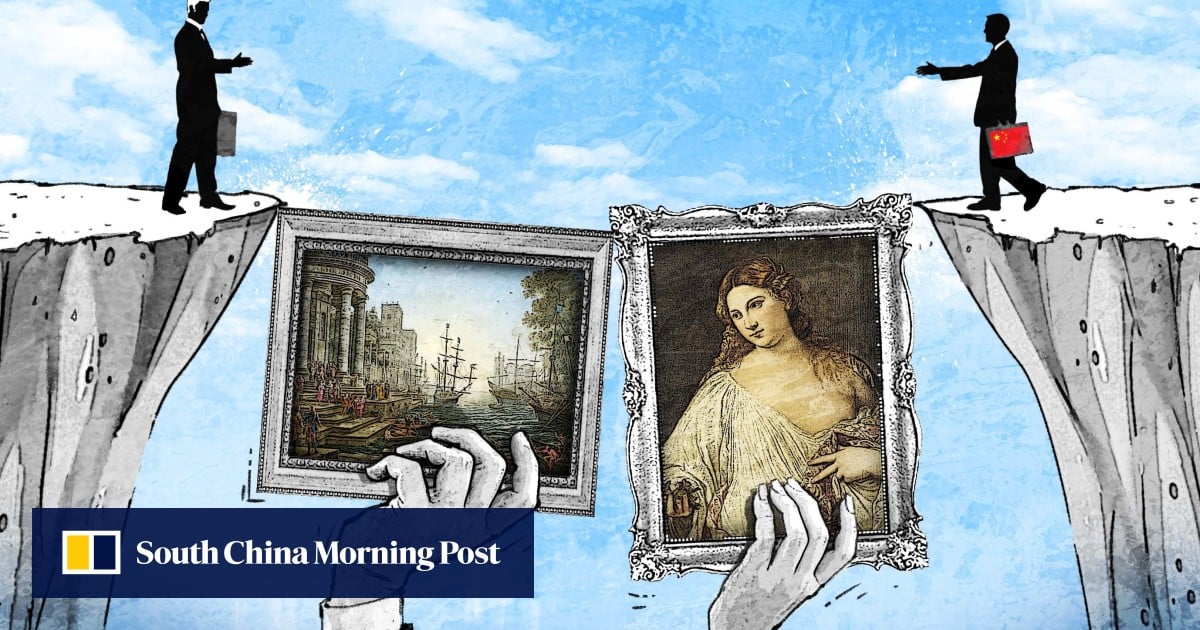Over at the Hong Kong Museum of Art, another major exhibition opened last month with 50 works by Italian masters including Titian, Giorgione, Tintoretto and Veronese, on loan from the Uffizi Galleries in Florence.
The show, “The Hong Kong Jockey Club Series: Titian and the Venetian Renaissance from the Uffizi”, began on November 3 and will close next February.
It is rare for two exhibitions with more than 100 works by major European artists to be happening in Hong Kong at the same time.
Before Hong Kong, the National Gallery paintings were shown in Shanghai and Seoul this year, while the Uffizi Galleries had other works from its collection displayed in Beijing in April.
Art Basel Hong Kong set to be biggest in years as 242 exhibitors sign up
Art Basel Hong Kong set to be biggest in years as 242 exhibitors sign up
The exhibitions are not only a treat for art lovers and visitors, but are also a charm offensive by the Europeans at a time of geopolitical tensions between China and the West.
Last week, Italy informed Beijing that it was withdrawing from China’s Belt and Road Initiative, while British Prime Minister Rishi Sunak previously described China as “an epoch-defining challenge” to the international order.
Speaking to the Post in November, Eike Schmidt, director of the Uffizi, which is part of Italy’s Ministry of Culture, said it was particularly important to underscore the strength of the relationship with cultural initiatives “to avoid any misunderstanding that the leaving of the Belt and Road Initiative would be a move away from China”.
“If art can give a contribution to the mutual understanding of people and to world peace, I see this only as very, very positive,” he added.

Beyond Hong Kong, the Uffizi has a strong presence on the mainland, having signed a deal with the Bund One Art Museum in Shanghai for 10 exhibitions over five years from 2022 that is expected to generate €6 million (US$6.5 million) for the Italian institution.
Gabriele Finaldi, director of the publicly funded National Gallery, said diplomatic gifts were often works of art, and cultural diplomacy had long proven effective in building ties.
The big picture: Renaissance art shown in Hong Kong as Uffizi urges closer ties
The big picture: Renaissance art shown in Hong Kong as Uffizi urges closer ties
The British gallery’s Shanghai show earlier this year was the most popular fee-charging exhibition in its history, drawing more than 420,000 visitors over 15 weeks. The 18-week run in Seoul drew 360,000 visitors.
Palace Museum director Louis Ng Chi-wa said he expected about 300,000 visitors during the exhibition’s 20 weeks in Hong Kong.
Finaldi said the Asian tour could pave the way for more collaborations with Hong Kong in future. Such moves could contribute to building bilateral ties.
‘Dialogue driven by culture’
In the background of the art diplomacy, there is the ongoing tension between the United States and other Western powers and Beijing.
In 2019, Italy surprised the US and Europe by joining Beijing’s ambitious Belt and Road Initiative, a massive infrastructure strategy to grow global trade by connecting China with the rest of Asia, Europe and beyond.
Critics see it as China’s tool to extend its geopolitical and economic clout.
In July, Italian Defence Minister Guido Crosetto called the decision to join the initiative “atrocious”, with observers saying Italy’s withdrawal would be seen as a major diplomatic setback for China.
Although Italy announced it would pull out, its government also said it aimed to maintain good ties with Beijing, reports said.
Speaking to the Post before the decision was made public, Italian ambassador to China Massimo Ambrosetti said Italy’s bilateral strategic partnership with China began in 2004, well before the belt and road plan.
He said culture was a basic part of Italy’s foreign policy, setting the framework for other collaborations, and the increasing number of artistic and cultural exchanges were “extremely promising”.
Aside from the Uffizi exhibitions, the Art Museum of Sichuan Fine Arts Institute hosted a Chinese-Italian contemporary exhibition in November and a joint show featuring Italian painter Lorenzo Chinnici and Chinese artist Zhu Wei was held at the University of Chinese Academy of Sciences in Beijing in June.
Last year, Zhejiang Art Museum hosted a showcase of contemporary Italian sculptures, and an Italian futurism art exhibition was held at Tsinghua University Art Museum in Beijing.
“To have dialogues, interactions and cooperation with foreign countries and peoples, you have to be aware of cultural identities and how they interact,” Ambrosetti said.
“We cannot simply focus on interests. Of course, the economy, business, and political cooperation are key. But the right framework for all these is the awareness of dialogue which is driven by culture.”
Hong Kong culture chief not ruling out arts hub as possible site for new museum
Hong Kong culture chief not ruling out arts hub as possible site for new museum
Pointing to long-standing investments by Italian firms in China, Ambrosetti added: “All these things have implicit political meaning. We have very, very positive friendly relations. We hope that our skies will be blue and without clouds in the future.”
Lau Siu-kai, a consultant for Beijing’s semi-official think tank, the Chinese Association of Hong Kong and Macau Studies, said cultural initiatives helped as gestures but might not be critical in bilateral ties.
“The most important areas of collaboration between countries remain in economy and foreign affairs, but cultural exchanges are beneficial for friendship between peoples,” Lau said.
He said the notion that Italy’s withdrawal from the belt and road strategy would anger Beijing was purely a Western narrative, whereas it was not a controversial matter for the Chinese.
“China has this self-confidence that as it develops, different countries will have to approach them and work with them,” he said. “Someone else will join if you’re not joining. You could also join another time if you’re not joining today, that’s very welcome. There is no need for hostility because of one incident.”
Associate professor Carl Vogt, who specialises in international relations at the University of Hong Kong, said the dynamic between Europe and China had reversed over the past four decades.
Europe was the dominant partner from 1980, but that changed around the time of the Beijing Olympics in 2008, when the continent faced a financial crisis.
“Ever since, China has become the more powerful partner,” he said, adding that where China once needed Europe more than Europe needed China, the situation was now the other way around.
“European companies are very, very, very well-invested in China, but they also make a lot of money there,” Vogt said. “There’s a hardening of positions – there’s no question about that – but there’s no strategic will anywhere to disengage from China.”
Cultural diplomacy, according to Vogt, was also part of a strategy to sell a certain kind of image of a country abroad that could then be followed up by tourism campaigns, such as the opening of flight routes, and there was an economic, commercial rationale that went beyond.
Regardless of any domestic political circumstances in Europe or China, he said, “it’s just a fact that the Chinese market is one of the biggest tourist markets in the world”.
Hong Kong’s arts funding examiners ‘will be required to safeguard national security’
Hong Kong’s arts funding examiners ‘will be required to safeguard national security’
‘It’s about getting to know each other’
The National Gallery’s Finaldi said he had been “astonished” by how well-received the Shanghai stop of the National Gallery tour was, and that the visitor numbers were very impressive.
He said sharing and discussing works of art would “inevitably bring about a much greater understanding between peoples and cultures”, and that was something he hoped to achieve with the exhibition in Hong Kong.
“Ultimately, it’s about getting to know each other,” he said. “This is an institutional collaboration, but it’s also about thousands of people coming to see these works, enjoying and learning from them.”
“I hope visitors who come see the show also go away with greater knowledge with greater curiosity, with a desire to know and learn more.”
Aside from the National Gallery, the British Museum signed a memorandum of understanding with the Hong Kong government in 2019. The museum also has many commercial collaborations on the mainland, while the UK’s Victoria and Albert Museum has set up a branch in Shenzhen in Guangdong province.
When British Prime Minister Rishi Sunak came to power in late 2022, he declared that the so-called golden era of UK-China relations was over.
But former foreign secretary James Cleverly subsequently rejected demands from some high-ranking members of the ruling Conservative Party to adopt a hardline approach against China, advocating instead for the UK to engage with Beijing in tackling “humanity’s biggest problems”, with Hong Kong remaining a sore spot.
In addition to Britain and Italy, France collaborated with Hong Kong’s Heritage Museum in April, bringing a virtual tour of the Palace of Versailles to the city, which also toured Shanghai and Macau.
To mark the 60th anniversary of diplomatic relations between China and France next year, Versailles and Beijing’s Palace Museum will stage an exhibition at the Forbidden City showing artefacts from both museums on Chinese-French relations in the 18th century.
“Exhibitions such as Versailles at the Forbidden City are an opportunity to celebrate the strong ties that unite our two countries and our two peoples,” a spokesperson for the French embassy in Beijing told the Post.
Master stroke: 52 famed paintings by European artists to go on show in Hong Kong
Master stroke: 52 famed paintings by European artists to go on show in Hong Kong
Political observer Lau said the international collaborations happening one after the other in Hong Kong were what Beijing wanted.
“They help underscore Hong Kong as an open, liberal and cosmopolitan city. It’s a role the Chinese government wants Hong Kong to play,” he said.
“It hopes Hong Kong will host more international events – conferences, exhibitions, or sports – to facilitate exchanges with the West and strengthen the city’s status as an international hub.”
Finaldi referred to the National Gallery’s 15th century painting Saint Jerome in his Study, by Antonello da Messina, now on display in Hong Kong, and stressed that culture did not exist just to serve other purposes.
“Culture somehow goes beyond the immediate circumstances,” he said. “Antonello da Messina’s pictures [still] speak to us centuries later, in completely different contexts, in completely different countries, in completely different languages.
“This is the beauty and power of culture. Culture can be manipulated of course, but if we share what’s really valuable about our cultures, that brings about understanding, and understanding ultimately brings harmony.”

